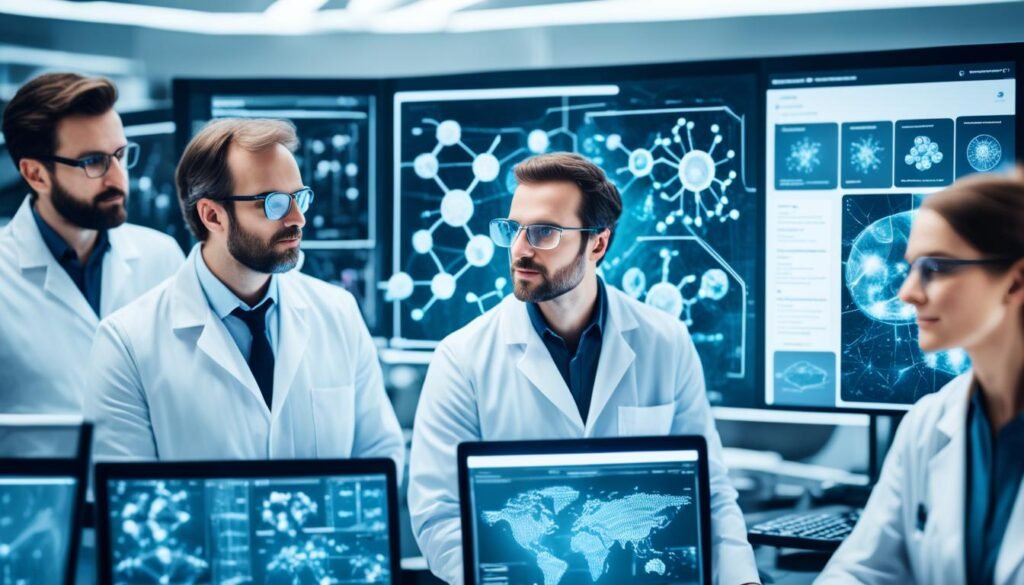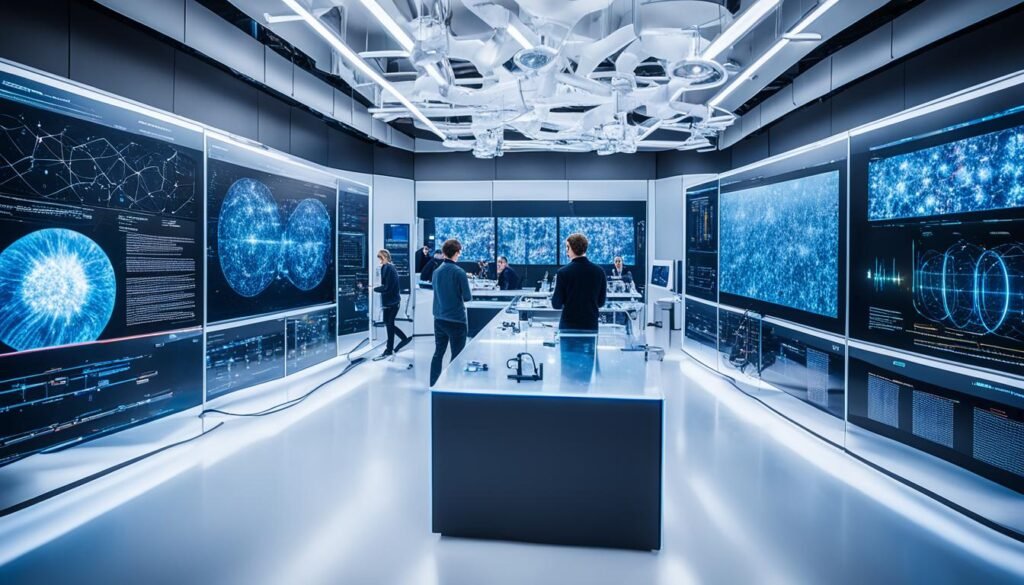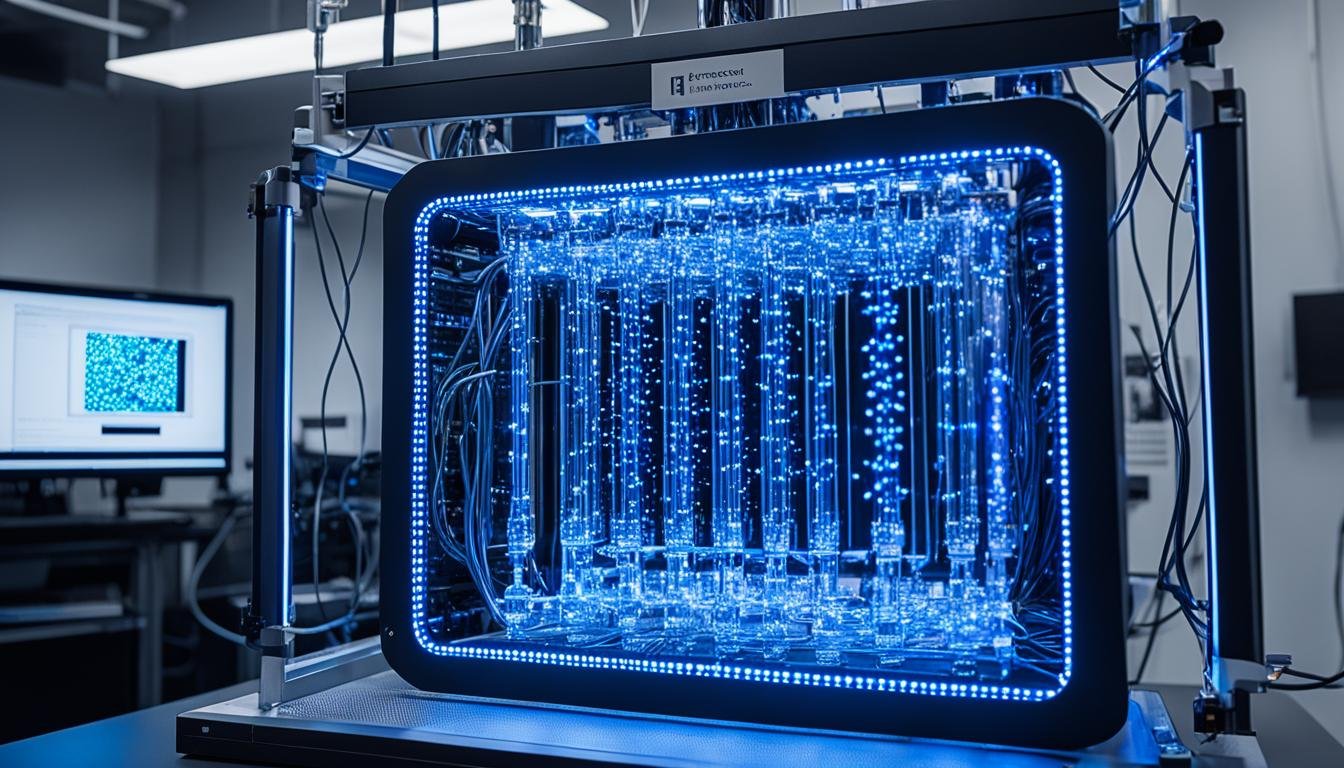Did you know that over 4,000 extrasolar planets have been found in other solar systems with AI’s help? This shows how AI is changing physics. Researchers are finding new ways to use AI to solve complex physics problems.
AI’s growth comes from better models, more data, and stronger hardware like GPUs. These advances help in many areas, including quantum technology. AI is speeding up research and giving us quicker insights in fields like finding new medicines and studying materials.
AI is also making quantum sensing, cryptography, and quantum communications better. This opens up new areas in science and tech.
Key Takeaways
- AI is changing physics, helping solve tough problems.
- AI’s growth comes from better models, more data, and stronger hardware.
- AI is making big leaps in quantum tech, speeding up research in fields like medicine and materials.
- AI is opening new doors in quantum sensing, cryptography, and communications.
- The mix of physics and AI is bringing new chances for discovery and innovation.
The Rise of AI and Its Impact on Physics
AI has made huge strides in physics, changing the game. It’s thanks to better models, more data, and stronger hardware like GPUs. These advances help with things like image recognition and self-driving cars. They also boost quantum technologies.
The Three Fundamental Roots of AI’s Ascent
AI models are now better at solving tough problems. They have a lot of data to work with, which is key. And with faster GPUs, they can process information quicker, speeding up AI progress.
Quantum Technologies and Their Intersection with AI
Quantum physics has been around for a hundred years, changing how we see the world. It’s behind many tech we use today, like lasers and MRI scanners. Now, new quantum tech is coming together with AI, making things move faster to market.
AI is key in making quantum tech better. It helps with secure communication and building quantum computers. This mix of physics and AI is leading to big breakthroughs in both areas.
As AI grows, it will keep changing how we understand and improve physics. This will lead to a future where AI and physics work together to explore the universe’s secrets.
Simulation: AI’s Accelerating Force in R&D
Artificial intelligence (AI) is changing how we do research and development (R&D) in many fields. It’s especially big in simulation. By combining AI with molecular simulations, scientists can now find and improve new drugs, materials, and sustainable solutions much faster.
Drug Discovery and Molecular Modeling
In the drug industry, AI has cut the time it takes to start drug discovery from years to just days. It does this through automated virtual screening in in silico drug design and discovery. AI can also design new molecules that are better than what scientists could make before, making it easier to find new drugs.
An AI platform, for example, found a potential cancer treatment in only 46 days. This is much faster than the old ways.
Materials Science and Sustainable Solutions
AI is also changing materials science. It lets scientists test new materials much faster. By trying out many materials without making them all, AI helps find materials that work better, are easier to get, and are better for the planet.
At the University of Cambridge, researchers used AI to make quantum dots that work 6 times better. This is a big step forward.
As AI gets better, it’s clear it’s making R&D faster and more efficient. It’s helping in many areas, from finding new drugs to making better materials. This could change our world for the better.

“AI in biology has allowed for the identification of key genomic features hidden in long interspersed meaningless regions through deep learning models scanning DNA and RNA data.”
Quantum Sensing Empowered by AI
Quantum technologies are getting better, and combining them with artificial intelligence (AI) opens new doors. Quantum sensors can spot tiny changes in things like gravity and magnetism. AI helps make sense of the data these sensors produce, picking out the important bits.
AI is great at filtering out the noise, making ai in quantum sensing tools smaller and more efficient.
Noise Mitigation and Signal Enhancement
New quantum sensors create a lot of data that’s hard to handle. AI steps in to sort through it all, find patterns, and understand what the data means. This helps scientists turn complex data into useful information for things like heart health checks and new GPS systems.
By using ai in noise mitigation and ai enhancing quantum sensor performance, scientists can fully use quantum sensing.
Deriving Actionable Insights from Complex Data
Quantum sensors produce a lot of data that’s hard to make sense of. AI helps by analyzing this data and finding important information. It spots patterns and uncovers hidden connections in the data.
This lets researchers and industries make better decisions, leading to new discoveries in many areas. ai-powered quantum sensing applications are changing how we see and interact with the world.
“The combination of quantum sensing and AI is a powerful tool that will revolutionize how we perceive and interact with the world around us.”
AI’s Role in Cryptography and Quantum Communications
The digital world is changing fast, making strong and safe ways to protect data more important than ever. AI has brought a new level of security with it. It can look at lots of data, spot unusual patterns, and find threats right away. This helps companies stay ahead of cyber threats and make their data safer.
AI is also key in quantum communications. It uses quantum physics to make secure networks. AI helps make these networks better by fixing problems and making them work better. This mix of AI and quantum tech is creating a future where our messages and data are super safe.
In today’s world, keeping our data private is crucial. AI is helping a lot with this. It uses less personal data and makes sure our info stays safe from hackers. This makes AI and quantum tech great for keeping our digital lives secure.
“AI is revolutionizing the way we approach cryptography and quantum communications, empowering us to build a more secure digital future.”

As AI and quantum tech work together, the future of online safety looks bright. Using AI in cryptography and quantum communications brings us new security and trust. This means we can have safer and more reliable online interactions.
can ai solve physics problems
AI-Driven Weather Prediction: A Digital Twin of Earth
Imagine a world where predicting the weather is a science, not a guess. Thanks to AI, this dream is coming true. AI is changing how we forecast and prepare for nature’s changes.
The FourCastNet model is a big step forward. It uses Adaptive Fourier Neural Operators (AFNO) to predict weather like wind speed and precipitation. This AI method can make a week-long weather forecast in just 10 seconds. It’s much faster than old methods, up to 45,000 times faster.
This tech change is huge for many fields. For wind energy, it helps plan better and make more power. Disaster teams can prepare for extreme weather better. And scientists can learn more about our climate, helping us fight climate change.
The future of weather prediction is with AI, and FourCastNet is leading the way. As AI gets better, we’ll get more accurate and timely weather forecasts. This will lead to smarter decisions that help everyone.
“The development of FourCastNet represents a major milestone in the quest to create a digital twin of our planet, enabling us to better understand and predict the intricate workings of Earth’s weather and climate.” – Dr. Janis Kemper, Lead Researcher, AI Weather Modeling Lab
Revolutionizing Wind Energy with Physics-Informed Neural Networks
The wind energy industry has found a new ally in Artificial Intelligence (AI). Siemens Gamesa, a top renewable energy company, uses physics-informed neural networks (PINNs) to change how we make wind energy.
Before, simulating a single wind turbine took 30-40 days. Trying to improve wind farms in real-time was hard, needing many simulations. But Siemens Gamesa has found a new way with AI-based physics simulators and PINNs.
This new method speeds up simulations, letting Siemens Gamesa check on many wind turbines in just minutes. The power of inverse physics simulation from PINNs means we can quickly optimize energy output. This is key for moving to sustainable energy sources.
| Key Advantages of PINNs in Wind Energy Optimization | Impact |
|---|---|
| Accelerated simulation times | From 30-40 days to mere minutes for simulating wind farms |
| Real-time optimization of energy output | Enables fine-tuning of wind farms to handle varying wind and weather conditions |
| Inverse physics simulation | Unlocks the power of lightning-fast optimization, driving the transition to sustainable energy |
Siemens Gamesa uses AI in wind energy optimization, physics-informed neural networks, and AI accelerating wind farm development. This has set a new standard for the renewable energy industry. This innovation shows how AI can solve complex physics problems and help us move to a sustainable future.

“The convergence of High Performance Computing (HPC) and Artificial Intelligence (AI) is expected to drive significant advancements in industries like healthcare, finance, manufacturing, aerospace, and automotive.”
AI and Medical Simulations: Saving Lives Through Visualization
Computer simulation has changed healthcare, especially in understanding blood flow. Thanks to ai in medical simulations, doctors can quickly and accurately analyze treatment outcomes. This is a big step forward.
Before, simulating blood flow took days or weeks for each patient. Now, with ai-powered blood flow analysis, doctors can try different scenarios in a day. This gives them a clear plan for each patient.
This tech is crucial for treating serious health issues like aneurysms. By using ai-assisted surgical planning, doctors can quickly analyze 3D scans. This helps them make better decisions and could save lives.
| Metric | Traditional Simulation | AI-Powered Simulation |
|---|---|---|
| Time to Analyze a Single Case | Days or Weeks | Minutes |
| Number of “What-If” Scenarios Explored per Day | Limited | Multiple |
| Potential to Save Lives | Limited | Increased |
AI in medical simulations is changing healthcare. It helps doctors make better decisions and could save more lives through visualization.
Generative AI: Unlocking New Frontiers in Physics Research
Physics research is changing fast, thanks to generative AI. Researchers have made a big leap by creating an AI framework. This framework maps phase diagrams for new physical systems automatically, similar to how ChatGPT works. It uses the natural patterns of physical systems, making it more efficient and accurate than old methods.
This tool lets scientists find new phases of matter and study materials we haven’t made yet. It opens up new areas in materials science and quantum computing. Generative AI is changing how we see complex physics, helping scientists discover faster and solve hard problems.
The Power of Generative AI Models
Generative AI uses advanced models like GANs and VAEs to create content, from art to music. These models are different from traditional AI because they aim to produce varied outputs. By combining quantum computing with AI, we could make these models even better at solving physics problems.
Navigating the New Frontier with Caution
Generative AI is a powerful tool, but it comes with challenges. Scientists need to balance AI’s power with their own insight. AI is powerful, but it can’t do everything on its own. Human oversight is still key. As we move forward with AI in physics, we must think about the ethical sides and keep AI as a tool for human discovery.
Using generative AI in physics needs careful human supervision and strict AI algorithms. We must set clear rules to avoid mistakes, biases, and misuse. By being careful, the science world can use generative AI in physics research, ai-powered scientific discovery, and ai-driven phase diagram mapping well. We also need to think about the ethical considerations in ai-driven physics research and the challenges of ai in scientific discovery.

Embracing the AI-Driven Future of Science
AI is changing science in big ways. It’s making tools for discovery and innovation better. This means a big change in how we solve complex problems in many industries.
To make the most of this, we need to learn more about AI. It’s important to understand how these technologies can help with scientific research. Working together, combining AI experts with experts in different fields, is key to using AI’s full power.
Using open-source AI tools, like the Julia Programming Language, makes AI more accessible. This lets researchers and professionals work together faster and innovate more.
As AI gets better, we must keep learning and adapting. People need to update their skills to keep up with new tech and ways of solving problems.
The future of physics and science is being shaped by AI. The big question is how fast we can adapt and lead. By focusing on ethics and making sure AI helps society, we can start a new era of discovery and progress.
“The new AI approach leverages inherent probability distributions of physical systems, eliminating the need for massive labeled datasets and making it more efficient and physics-informed.”
The future of science with AI is exciting for tech and science professionals. By embracing this change, we can explore science in new ways. This leads to a more innovative, collaborative, and ethical future.
Conclusion
Artificial intelligence (AI) has changed physics in big ways, opening up new areas for research and innovation. It helps speed up finding new medicines and materials, and it makes quantum sensing and secure communication possible. AI is now key in understanding the physical world.
As we move forward with AI in science, we must be both excited and careful. Using AI wisely and with ethics can lead to huge discoveries. These discoveries will change how we see the universe.
AI’s role in physics is clear: it looks through huge amounts of data, finds patterns, and uncovers secrets that were hard to see before. It also helps physicists deal with the noise and uncertainty in data. This makes it easier to spot important signals and plan better experiments.
FAQ
Can AI solve physics problems?
Yes, AI is now key in solving complex physics problems. It uses advanced AI models, lots of data, and better hardware. This helps in fields like quantum tech, predicting weather, and studying materials.
How is AI impacting the field of quantum technologies?
AI is crucial for quantum tech. It speeds up research and development. It also helps with quantum sensing, cryptography, and communications.
What are the key applications of AI in scientific research and development?
AI helps in finding new medicines, modeling molecules, and studying materials. It makes simulations faster and helps in quantum sensing. It also finds important insights in complex data.
How is AI revolutionizing weather prediction and wind energy generation?
AI makes weather forecasts fast and accurate. This helps plan for renewable energy and extreme weather. AI also changes how wind farms work for better efficiency.
What are the challenges and ethical considerations in using AI for physics research?
Using AI in physics research brings new challenges. Scientists must balance AI’s power with human insight. It’s important to use AI ethically for the good of society.
How can businesses and professionals capitalize on the AI-driven transformation in science?
To use AI in science, invest in learning about AI. Work together across different fields. Use open-source tools and keep learning. Always think about the ethics of using AI.
